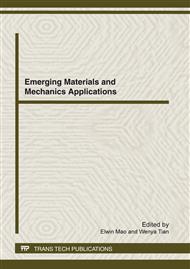[1]
O. M. Jensen, P. F. Hansen, Autogenous deformation and change of the relative humidity in silica fume-modified cement paste, ACI Materials Journal. 6 (1996) 539-543.
DOI: 10.14359/9859
Google Scholar
[2]
S. Weber, H. W. Reinhardt, A new generation of high performance concrete: concrete with autogenous curing, Advanced Cement Based Materials. 6 (1997) 59-68.
DOI: 10.1016/s1065-7355(97)00009-6
Google Scholar
[3]
A. M. Neville, P. C. Aitcin, High performance concrete-An overview, Materials and Structures. 33 (1998) 111-117.
Google Scholar
[4]
E. E. Holt, Early age autogenous shrinkage of concrete , VTT Publication 446, Technical Research Center of Finland, (2001).
Google Scholar
[5]
S. E. Pihlajavaara, A review of some of the main results of a research on the ageing phenomena of concrete: Effect of moisture conditions on strength, shrinkage and creep of mature concrete, Cement and Concrete Research. 5 (1974) 761-771.
DOI: 10.1016/0008-8846(74)90048-9
Google Scholar
[6]
F. Skoczylas, N. Burlion, I. Yurtdas, About drying effects and poro-mechanical behavior of mortars, Cement and Concrete Composites. 29 (2007) 383-390.
DOI: 10.1016/j.cemconcomp.2006.11.008
Google Scholar
[7]
L. J. Parrott, Water absorption in cover concrete, Materials and Structures. 25 (1992) 284-292.
Google Scholar
[8]
F. H. Wittmann, Surface tension shrinkage and strength of hardened cement paste, Materials and Structures. 1 (1968) 547-552.
DOI: 10.1007/bf02473643
Google Scholar
[9]
T.C. Powers, T. L. Brownyard, Study of physical properties of hardened Portland cement paste, Journal of American Concrete Society. 8 (1947) 67-87.
Google Scholar
[10]
T.C. Powers, The thermodynamics of volume change and creep, Materials and Structures. 1 (1968) 443-463.
Google Scholar
[11]
J. H. M. Visser, Extensile hydraulic fracturing of (saturated) porous materials, Phd Thesis, Delft University, the Netherlands, (1998).
Google Scholar
[12]
F. H. Wittmann, Surface tension, shrinkage and strength of hardened cement paste, Materials and Structures. 6 (1978) 547-552.
Google Scholar
[13]
R. F. Feldman, P. J. Sereda, A model of hydrated Portland Cement Paste as deduced from sorption length change and mechanical properties, Materials and Structures. 11 (1968) 509-519.
DOI: 10.1007/bf02473639
Google Scholar
[14]
C. Hua, A. Ehrlacher, P. Acker, Analysis and models of the autogenous shrinkage of hardening cemnent paste: I. Modeling at macroscopic scale, Cement and Concrete Research. 25 (1995) 1457-1468.
DOI: 10.1016/0008-8846(95)00140-8
Google Scholar
[15]
C. Hua, A. Ehrlacher, P. Acker, Analysis and models of the autogenous shrinkage of hardening cemnent paste: Ⅱ. Modeling at scale of hydrating grains, Cement and Concrete Research. 27 (1995) 245-258.
DOI: 10.1016/s0008-8846(96)00202-5
Google Scholar
[16]
E. A. B. Koernders, K. van Breugel, Numerical modeling of autogenous shrinkage of hardening cement paste, Cement and Concrete Research. 27 (1997) 1489-1499.
DOI: 10.1016/s0008-8846(97)00170-1
Google Scholar
[17]
E. A. B. Koernders, K. van Breugel, Modeling dimensional changes in low water/cement ratio pastes, Cement and Concrete Research, 11 (1998) 231-240.
Google Scholar
[18]
T. Ishida, R. P. Chaube, T. Kishi, K. Maekawa, Microphysical approach to coupled autogenous and drying shrinkage of concrete, Proceedings of Intern Workshop on Autogenous Shrinkage of Conrete, JCI, Hiroshima, 1998, pp.301-312.
DOI: 10.2208/jscej.1997.578_111
Google Scholar


